![]()
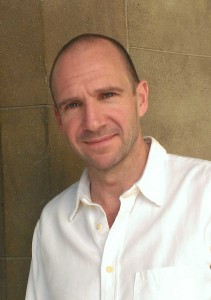
That gap has now been admirably filled by a new film, The Invisible Woman, starring Ralph Fiennes who also directs. The movie portrays Dickens at the height of his fame, revealing him to be as fascinating as any of the well-known characters he created – and more sexual.
This is not the kind of biopic that covers an entire life. Its focus is specifically on a long-secret love affair Dickens had with a young actress, Nelly Ternan, played by Felicity Jones, who was only 18 when she met the author. At the time he was also married and had 10 children. As gossip began to bubble, he abruptly cut the affair off, fearing it would become public and damage his career. Ternan lived out the rest of her life, reinventing herself and marrying. But when it came to her intimate years with Dickens, she remained invisible – hence the title of the film.
Fiennes revealed he didn’t know that much about Dickens when he was approached to direct the project. “I had only read one or two of his books,” said the acclaimed stage and screen star, twice nominated for an Oscar for his supporting role in Schindler’s List and as best actor in The English Patient. To the broader public he’s best known for playing arch villain Voldemort in the Harry Potter series of movies.
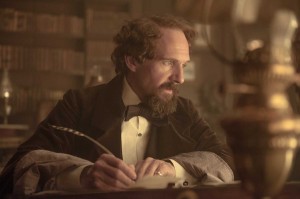
The film is based on a book of the same name by Claire Tomlin that came out in 1990 and first detailed the hidden relationship, causing quite a stir in literary circles. It was turned into a screenplay by Abi Morgan.
Fiennes was directing his first film, Coriolanus (2011), based on William Shakespeare’s play about an unyielding and merciless Roman general, in which he also starred, when he got the script and found it immensely appealing. However, he had to be coaxed into also starring, but that turned out to be a case of perfect casting given the way Fiennes convincingly portrays Dickens.
Now with two films under his belt, Fiennes’ new passion is directing. “I love the collaboration, with the writer and the crew,” he declared. He assembled a top-flight production team consisting of previous collaborators and some newcomers.
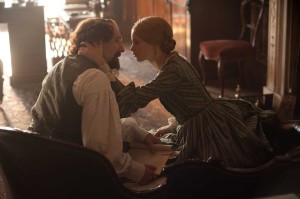 The editor was Nicolas Gaster, who also cut Coriolanus. Award-winning hair and makeup artist Jenny Shircore he met on the 2011 remake of Great Expectations in which he played Magwitch. He encountered costume designer Michael O’Connor when he starred in The Duchess (2007) – a lavish period drama that garnered an Oscar for O’Connor.
The editor was Nicolas Gaster, who also cut Coriolanus. Award-winning hair and makeup artist Jenny Shircore he met on the 2011 remake of Great Expectations in which he played Magwitch. He encountered costume designer Michael O’Connor when he starred in The Duchess (2007) – a lavish period drama that garnered an Oscar for O’Connor.
Maria Djurkovic was selected to be his production designer. She received kudos for her work on Tinker Tailor Soldier Spy (2011). Fiennes said his first choice for cinematographer was Barry Ackroyd, who photographed The Hurt Locker in which Fiennes had a role, but he had committed to lensing Captain Phillips. So Fiennes went instead with director of photography Rob Hardy, for his impressive work on Shadow Dancer (2012).
The DP is usually right beside the director throughout a shoot, but since Fiennes was also often in front of the camera, he relied especially on Hardy to get it right. “I had a creative love affair with Rob,” said the director. “I wanted someone to shoot very strong frames – to look for strong composition that would focus on the human face, to bring out the interior life of the characters,” he said. “Rob managed to accomplish that magnificently in his cinematography.”
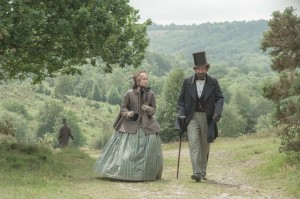 There were two contrasting looks to the film. The beginning and ending scenes show Ternan years later ruminating on her relationship with Dickens while wandering the seashore against a blue sky. Fiennes wanted a somewhat melancholy and desaturated palette for these 1870s sequences. Hardy shot the scenes on the Camber Sands near Kent in the south of England, capturing a low, wintery light. By contrast, the centerpiece scenes set 15 years earlier, when Nelly and Dickens meet and become paramours, are more colorful and vibrant.
There were two contrasting looks to the film. The beginning and ending scenes show Ternan years later ruminating on her relationship with Dickens while wandering the seashore against a blue sky. Fiennes wanted a somewhat melancholy and desaturated palette for these 1870s sequences. Hardy shot the scenes on the Camber Sands near Kent in the south of England, capturing a low, wintery light. By contrast, the centerpiece scenes set 15 years earlier, when Nelly and Dickens meet and become paramours, are more colorful and vibrant.
Fiennes approached the project by asking all the department heads to pay close attention to details. “I really wanted it to reflect the period, but not to overly romanticize it or make it too Queen Victoria stuffy,” he stated. The look of 19th Century England was carefully researched and recreated. Fiennes felt strongly that the way into the period drama for the audience was to make it appear as real as possible. When Dickens burns his letters, they come folded just as they would have been. At the race track scene, the crowd of extras shout the actual names of the horses that raced at Doncaster on Derby Day in 1857. “I believe that if everything is very detailed, audiences feel the world,” Fiennes noted.
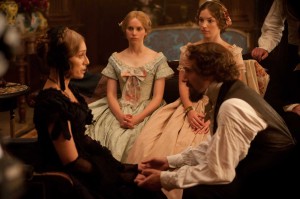 One of the major reference points for this was William Powell Frith’s well-known panoramic painting “The Derby Day” of circa 1850, which was pored over for costume and production design elements. Dickens’ Gads Hill home and other interiors, were shot in Georgian and Victorian houses in London. The challenge for production designer Djurkovic was to find houses which hadn’t been modernized with contemporary fittings, and could be more easily be dressed for period accuracy.
One of the major reference points for this was William Powell Frith’s well-known panoramic painting “The Derby Day” of circa 1850, which was pored over for costume and production design elements. Dickens’ Gads Hill home and other interiors, were shot in Georgian and Victorian houses in London. The challenge for production designer Djurkovic was to find houses which hadn’t been modernized with contemporary fittings, and could be more easily be dressed for period accuracy.
The interior of the railway carriage for the critical train crash sequence where Nelly, traveling with Dickens is injured was filmed on sets in London. The exteriors of the derailment were staged in a siding of the Bluebell Railway, which operates heritage steam locomotives, in Sussex.
Besides the Frith painting and others by Dickens contemporary Augustus Egg, costume designer O’Connor looked at photography from the era, to explore how the clothes of the time would have been constructed. Fiennes insisted that characters wear their costumes more than once, more true-to-life than having new clothes for each scene.
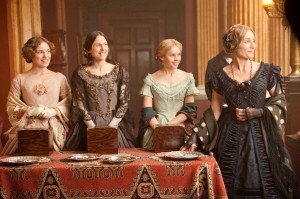 Fiennes said he was quite involved in every aspect of pre-production. “I asked the crew heads, ‘tell me what I should know,’” he recalled, “I wanted to be aware of everything happening on the set.” And, having a pretty good sketching ability, he drew many of the storyboards himself.
Fiennes said he was quite involved in every aspect of pre-production. “I asked the crew heads, ‘tell me what I should know,’” he recalled, “I wanted to be aware of everything happening on the set.” And, having a pretty good sketching ability, he drew many of the storyboards himself.
In the cutting phase, he worked closely with editor Gaster. “You have to relearn the film,” said Fiennes of the editing process. At first he winced watching himself perform but he soon grew dispassionate in whittling the film down to two hours. Because of a sparse budget, postproduction including the edit was compressed into five months. “It would have been relatively cheap to keep the editor editing longer,” he said. “But you lock in your postproduction people like the sound mixer, so if you go over, you have to pay them to stay on or risk losing them, and that inflates costs and the budget.”
Fiennes said he would like to direct more movies, but his main activity will continue to be performing in films directed by others. His credits, in addition to those already mentioned, include The Constant Gardener, Shame, In Bruges and Skyfall. He recently finished starring in Wes Anderson’s The Grand Budapest Hotel. Despite an impressive stage career – he was a member of the Royal Shakespeare Company and has appeared on Broadway – he’s never directed a play, but that is another goal for Fiennes.





